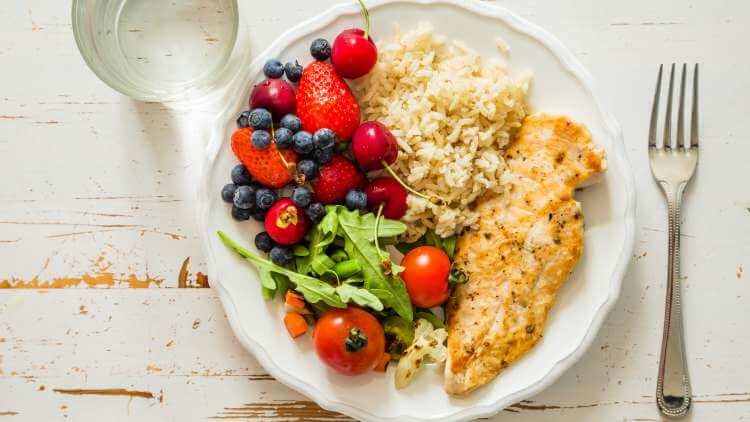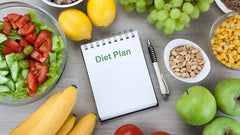
8 Easy Steps to Get a Grip on Portion Control
When you want to lose weight, it’s best to start with your diet. And though many people have a general sense of what’s good for them and what isn’t, many still struggle to lose weight. But it isn’t because they aren’t trying or aren’t eating the right foods.
Often, it’s because they’re eating the wrong portion sizes.
Practical approaches to portion control
Portion control is especially challenging today. Portions in restaurants are bigger than ever. Even the portions of meats and other foods in your grocery store are getting larger every year. In fact, some studies reveal that since the 20th century, portions have grown between two and five times in size.
As a smart dieter, it’s important that you understand portion and serving sizes, and how these relate to weight loss. We discuss these points below and give you some quick tips to keep you on track, and ensure that you always know how much to put on your plate!
PORTION SIZE BASICS
Do you know the difference between a serving size and a portion? If not, it’s best to start with the basics:
- Serving Size: A serving size is the amount of food listed on a product’s label specifying how much of it you should eat.
- Portion: A portion is the amount of food you choose to eat at one sitting. This is related to the total amount of food you put on your plate.
People often believe that they’re eating a recommended serving size when actually, they have a much bigger serving on their plate. So, while they think they’re consuming the listed amounts of fats, carbohydrates, protein, and calories, they’re actually getting far more. This can push even the best-intentioned dieters off track.
Allocating portion sizes before beginning to eat is important. It’s easy to put food on a large plate and not realize how much you’re eating until the meal is complete. By being mindful of portions as you cook and plate your meals, you’ll be more aware of what you’re eating, and it will be easier to stay on track.

PORTION SIZES AND WEIGHT LOSS
Without tracking portion sizes, you’re going to have a difficult time losing weight. After all, eating more than your body needs means that no amount of exercise will get your weight loss back on track.
Many dieters struggle with portion sizes when they aren’t eating prepackaged foods. And because fresh produce should be the focus of any healthy diet, it’s important to understand how to track portion sizes of your favorite proteins, fruits, vegetables, and grains. Here are a few examples…
A single serving of:
- A vegetable or piece of fruit should be about the size of your fist.
- Pasta is approximately the same size as a scoop of ice cream.
- Protein like meat, fish, or poultry is the same size as your palm without the fingers, or a deck of cards.
- Steamed rice or other grains should fill a cupcake wrapper.
- Snacks like pretzels and chips should fit into a cupped hand.
Keep in mind that grains, dairy products, and many packaged proteins come with serving sizes on the label. For all other fresh produce, you should use these general rules of thumb to stay on track.
Practical portion control tips
There tend to be two aspects that need to be addressed when it comes to portion control; sufficiency and satisfaction. Sufficiency is all about consuming the correct amount of food without overeating excess calories. Satisfaction focuses on feeling full after a meal and not deprived or hungry.
Here are some practical strategies that can help you address both:
1. Measure everything
You might think that it’s easy to eyeball a portion size, but it usually isn’t! Before you know it, you might have eaten two or three servings of even a healthy snack, which is too many calories for what you probably need when you’re trying to lose weight.
Invest in measuring cups, measuring spoons, and a food scale. A food scale is especially important for measuring protein serving sizes, and can be more accurate than other methods. You may even want to pre-measure snack portions when you open a larger container or bag of something. That way, you can grab food and go, without having to measure every time (or finding an excuse not to measure).

2. Use smaller bowls & plates – Invest in portion control plates
The size of your plates and bowls has a profound effect on determining your portion size. Most of us will automatically fill up our plate with food, which means we’re being influenced by the crockery instead of how much we really need.
Numerous scientific studies have examined whether the size of someone’s plate can impact their perception of how much food is really there. Results overwhelmingly show that portions seem smaller when served on a large plate. This leads to people unconsciously overeating without even realising it.
Knowing how much each plate, bowl, or other dish holds is essential to becoming even slightly skilled at guessing how much you’re eating if you aren’t going to measure. Thus, while a scale or measuring cups are best, investing in smaller dishes can also help you keep portions in check.
3. Read the labels
It might sound surprising, but many of us don’t actually know what a ‘correct’ portion size should be. We tend to go by the portions that our parents served up for us as a child, or how much a restaurant gives us. But these aren’t necessarily the correct sizes for a balanced diet.
An easy solution is to read the nutritional labels on food packets. They include an estimate of what a correct serving is, based on the average requirement of 2000 calories per day for an adult. For example, an individual serving of pasta is considered 75g which is about 1/6 of a small packet, but some people will easily eat twice as much as this without thinking about it. Checking the labels can help you to determine how much to cook per person and manage portion control.

4. Never eat from a container with more than one serving
When you eat out at a restaurant, or even when you open a bag of something at home, chances are there are two, three, or even more servings there. Unfortunately, few people think about this and just consider all of the food in front of them, especially if it seems like it should be a single serving, to be a single serving.
The best way to approach this portion control related problem is to find a solution before it begins. For example, always read food labels to figure out how many servings are in a package before you dig in. At a restaurant, ask the server to put away half of your meal in a takeaway portion container before it’s served. These simple tips will prevent you from overeating by removing the food that’s in front of you.
How to Stop Binge Eating Cycle >>
5. Decide in advance
For many of us, portion control isn’t something we think about – it’s just something we accept. But it’s this passive approach that can get us into trouble if it leads to unconscious overeating. One surprisingly effective strategy is simply to decide in advance how much we intend to eat. It might be resolving not to reach for the bread basket when out for dinner, or just having two squares of chocolate instead of the whole bar. This approach may not work for everyone, but making a commitment to portion control can be an effective step.
6. Drink more water
Did you know that it’s easy to mistake thirst for hunger? It can be, but there are other benefits to drinking water, too!
Water makes you less likely to overeat because it takes up space in your stomach. Dehydration can also cause hunger-like symptoms, so it’s almost always best to drink up before you reach for food.
7. Change the way you eat
Sometimes, during everyday meals, eating feels like a race. But should it?
You can create an atmosphere that encourages slower eating by dimming the lights and turning on music. And while you’re at it, turn off the television and put down your phone! By creating a calm, enjoyable atmosphere, it will feel nice to eat more slowly. Moreover, you should put down your fork or spoon between bites, and drink water. Doing so will help you realize when you’re getting full, which can help further decrease portion sizes and potential overeating.
How to make healthy food taste better >>
8. Don’t skip meals
Skipping a meal might seem like the ultimate portion control, but it isn’t. In fact, skipping meals will only cause you to become more hungry as the day goes on, increasing the likelihood that you’ll overeat.
You should eat at least three times a day, and should ideally be eating regular, healthy snacks in between meals as well. Doing so will keep hunger at bay, rev up your metabolism, and sustain energy.
Take control of your portion sizes and lose weight!
Whether you’re already trying to watch your portion sizes and aren’t sure of the best way to do so or are new to a healthier lifestyle and want tips on how to get started, the 8 tips above are a great way to begin or continue your weight loss regimen!
PORTION CONTROL: YOUR WAY TO WEIGHT LOSS SUCCESS
These practical approaches to portion control can help you manage your calorie intake and gradually lose weight. Being proactive about your portions is the first step, no matter which method you decide to go with. There is no one-size-fits-all solution as we’re all individuals with unique eating habits. Ultimately, we all need to learn to listen to our bodies and respond to what it’s trying to tell us, but this can seem difficult when first starting our weight loss journey. The key is trying different methods and finding the one that works for us.
How do you manage your portion sizes? We’d love to hear about it in the comments below…




